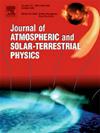Long-term drought characterization: A spatiotemporal analysis in Rayalaseema, southern peninsular India
IF 1.9
4区 地球科学
Q3 GEOCHEMISTRY & GEOPHYSICS
Journal of Atmospheric and Solar-Terrestrial Physics
Pub Date : 2025-02-17
DOI:10.1016/j.jastp.2025.106467
引用次数: 0
Abstract
The unique combination of features in Andhra Pradesh's Rayalaseema region makes it an ideal location for drought studies. These features include hilly terrain, a semi-arid climate with the lowest rainfall in India, and the influence of both the Southwest and Northeast monsoons. Rainfall is a fundamental metric for water availability, while temperature plays a pivotal role in regulating evapotranspiration rates. Understanding their trends is crucial since both factors are integral in delineating drought conditions. This study delves into the drought dynamics of the Rayalaseema region from 1961 to 2021, employing meteorological drought indices: the standardized precipitation evapotranspiration index (SPEI) and the standardized precipitation index (SPI). In order to achieve this, rainfall data was retrieved from the archives of the India Meteorological Department (IMD), while temperature data was sourced from ERA-5 (the fifth-generation European Centre for Medium-Range Weather Forecasts reanalysis). In order to assess the significance of drought characteristic trends across various temporal and spatial scales, the Mann-Kendall trend test and Sen's slope estimator techniques were applied. Rainfall patterns varied significantly, with Kurnool receiving the highest and Anantapur the lowest, while temperatures steadily increased, peaking in the sixth decade, especially in Kadapa, Kurnool, and Chittoor, with June being the warmest month. Rainfall trends shifted from negative to positive, with Kurnool and Chittoor experiencing significant increases, while Kadapa and Anantapur continued to face negative trends. Drought conditions, as measured by SPI and SPEI, were frequent, particularly in the first three decades, with a shift towards wetter conditions in later decades. The SPEI trends revealed rising drought severity, exacerbated by increasing temperatures, particularly in Kurnool and Kadapa. Nonetheless, both indices effectively capture significant drought events, with SPEI detecting more severe drought occurrences than SPI.
长期干旱特征:印度半岛南部Rayalaseema的时空分析
安得拉邦Rayalaseema地区独特的特征组合使其成为干旱研究的理想地点。这些特征包括丘陵地形,印度降雨量最低的半干旱气候,以及西南和东北季风的影响。降雨是水分可用性的基本度量,而温度在调节蒸散速率方面起着关键作用。了解它们的趋势是至关重要的,因为这两个因素都是描述干旱条件的组成部分。利用标准化降水蒸散指数(SPEI)和标准化降水指数(SPI)对1961 - 2021年拉雅拉西玛地区干旱动态进行了研究。为了实现这一目标,降雨量数据来自印度气象部门(IMD)的档案,而温度数据来自ERA-5(第五代欧洲中期天气预报再分析中心)。为了评估干旱特征趋势在不同时空尺度上的意义,采用了Mann-Kendall趋势检验和Sen's斜率估计技术。降雨模式变化显著,库尔努尔最高,阿南塔普尔最低,而气温稳步上升,在第六个十年达到峰值,特别是在卡达帕、库尔努尔和奇图尔,6月是最温暖的月份。降雨趋势由负向正转变,库尔努尔和奇图尔经历了显著的增长,而卡达帕和阿南塔普尔继续面临负趋势。根据SPI和SPEI的测量,干旱条件是频繁的,特别是在前三十年,在后来的几十年里转向湿润条件。SPEI趋势显示干旱严重程度上升,气温升高加剧了干旱严重程度,特别是在Kurnool和Kadapa。尽管如此,这两个指数都有效地捕获了重大干旱事件,SPEI比SPI检测到更严重的干旱事件。
本文章由计算机程序翻译,如有差异,请以英文原文为准。
求助全文
约1分钟内获得全文
求助全文
来源期刊

Journal of Atmospheric and Solar-Terrestrial Physics
地学-地球化学与地球物理
CiteScore
4.10
自引率
5.30%
发文量
95
审稿时长
6 months
期刊介绍:
The Journal of Atmospheric and Solar-Terrestrial Physics (JASTP) is an international journal concerned with the inter-disciplinary science of the Earth''s atmospheric and space environment, especially the highly varied and highly variable physical phenomena that occur in this natural laboratory and the processes that couple them.
The journal covers the physical processes operating in the troposphere, stratosphere, mesosphere, thermosphere, ionosphere, magnetosphere, the Sun, interplanetary medium, and heliosphere. Phenomena occurring in other "spheres", solar influences on climate, and supporting laboratory measurements are also considered. The journal deals especially with the coupling between the different regions.
Solar flares, coronal mass ejections, and other energetic events on the Sun create interesting and important perturbations in the near-Earth space environment. The physics of such "space weather" is central to the Journal of Atmospheric and Solar-Terrestrial Physics and the journal welcomes papers that lead in the direction of a predictive understanding of the coupled system. Regarding the upper atmosphere, the subjects of aeronomy, geomagnetism and geoelectricity, auroral phenomena, radio wave propagation, and plasma instabilities, are examples within the broad field of solar-terrestrial physics which emphasise the energy exchange between the solar wind, the magnetospheric and ionospheric plasmas, and the neutral gas. In the lower atmosphere, topics covered range from mesoscale to global scale dynamics, to atmospheric electricity, lightning and its effects, and to anthropogenic changes.
 求助内容:
求助内容: 应助结果提醒方式:
应助结果提醒方式:


